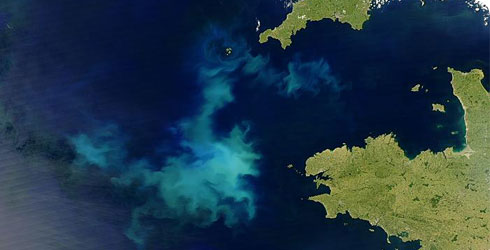Behaviour
Blooms
Individual Emiliania huxleyi cells can only be seen with the help of microscopes, but periodically they occur together in enormous blooms which can be clearly seen from satellites.
Algal blooms occur when the conditions are ideal for the species forming them resulting in explosive population growth. In the case of E. huxleyi this can lead to populations of 1 to 10 million cells per litre, and in addition hundreds of millions of loose coccoliths floating in the water. This turns the water milky white, in contrast to green or red water produced by other phytoplankton species.
A few other coccolithophores are known to form blooms but E. huxleyi is by far the most important bloom forming species.
E. huxleyi blooms typically occur in early summer, in temperate waters along the edge of the continental shelf. Areas with regular blooms include:
- the seas west of Britain
- the North Sea
- the shelf edge around the Falklands and Argentina
- the Bering Sea, (between Alaska and Siberia)
- the Black Sea
-

Viruses and the termination of blooms
Emiliani huxleyi blooms are brought to an end by viruses that infest the coccolithophores, killing them. Learn about the different theories that have been put forward to explain the dynamics between the E. huxleyi and virus populations.
